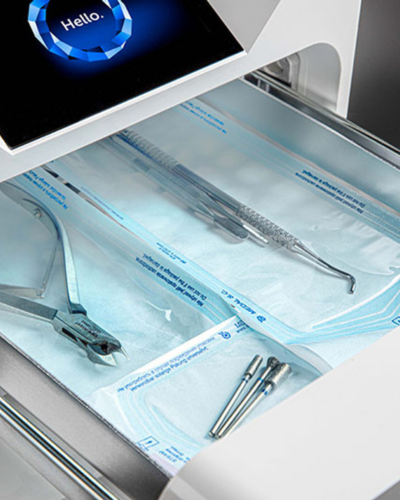
Instrument Staining and Pitting of Surgical Instruments
Stains are discoloration of metal by material being just added to the surface of the metal. Stains are often mistaken for rust- an actual change to the metal material. A brown/orange color stain is the most common and is often mistaken for rust. The brown/orange color stain is usually a phosphate deposit on the instrument. Phosphate can come from traces of minerals in the autoclave water source, a dirty autoclave, high alkaline or acidic detergents, surgical wrappings, and dried blood or tissue. Hot steam in the autoclave deposits the phosphate and produces the stain on the instrument’s surface. Remove this type of stain from the instrument by rubbing with a pencil eraser (rust cannot be removed by an eraser).
A brown/orange stain or a blue-black stain can occur from plating during the cleaning or autoclaving process. Through electrolysis when dissimilar metals touch while being autoclaved, ultrasonically cleaned, or sometimes even stored together, plated stains actually bond the stain material to the instrument metal. They do not often change the metal material except for the discoloration. These stains are very difficult to remove and should be sent to a surgical instrument service facility for refinishing.
Black stains are usually due to an acid reaction. An acidic detergent deposit left on the instrument during autoclaving might cause a black stain. Always use neutral pH detergents and distilled deionized water in your autoclave process, and be sure to completely rinse instruments before autoclaving.
Multi-colored stains or chromium oxide stains result from excessive heat. These rainbow colour stains indicate the instrument may have lost some of its original hardness after being heated. Cutting edges lose their sharpness quickly when hardness is reduced. Flash flame decontamination (an instrument is decontaminated by inserting it into a flame for a few seconds) changes the molecular structure of most material adversely, shortening the useful life of instruments.
Pitting
Avoid the problem of pitting by using only pH neutral (7.0) detergents and making sure all instruments placed in the autoclave are thoroughly rinsed before being put in the autoclave.
Pitting can also occur if dissimilar metals come in contact with each other in an ultrasonic cleaner or autoclave. Electrolysis from dissimilar metals touching in a solution (the steam in the autoclave acts as a conductive solution that allows electrolysis) transfers metal molecules from one instrument to the other, leaving pits in one instrument.
Avoid having any instruments touching during autoclaving, cleaning or storage to eliminate pitting.
